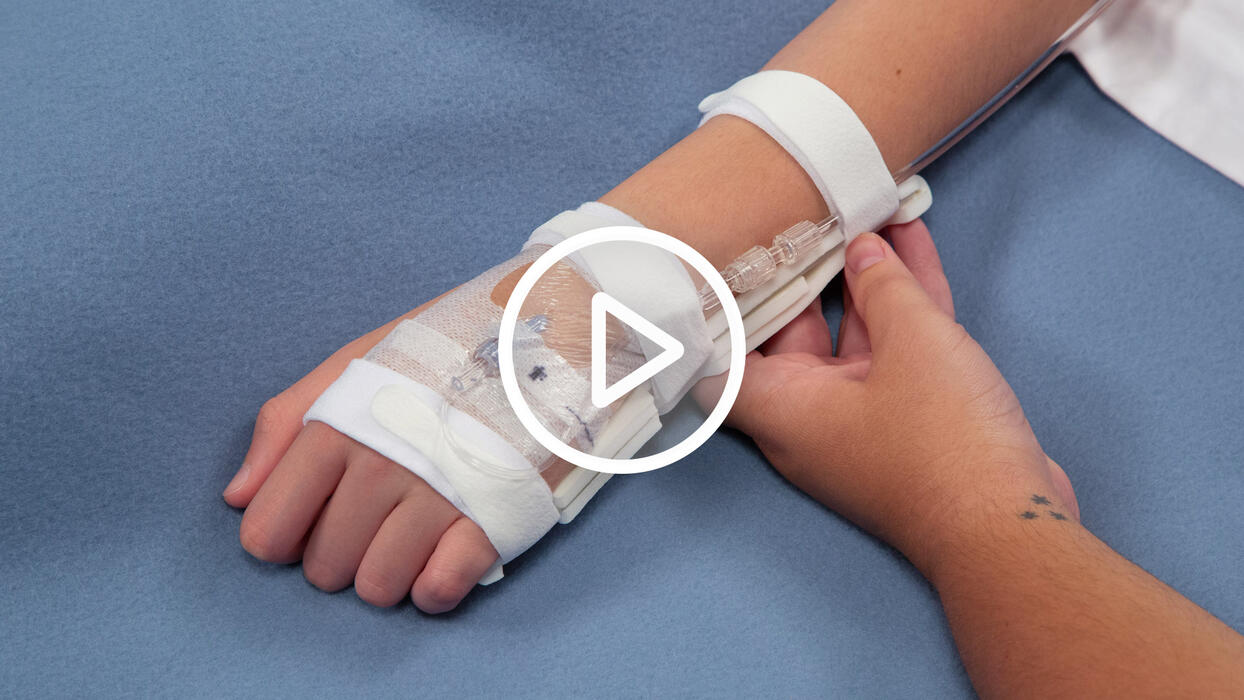The TLC Wrist Splint is available with or without straps and is ergonomically designed to hold the hand and wrist in the functional position for IV therapy infusion. This revolutionary armboard gives nurses a 360° view of the IV insertion site and surrounding tissue so nurses and other stakeholders can spot early warning signs of complications, including infiltration and extravasation.
Contact Us to learn more.
The TLC Wrist Splint is ergonomically designed to fit the natural shape of the wrist and forearm while increasing access and visualization for easier assessments.
The TLC Wrist Splint is available with or without straps. This video will demonstrate the application of both products.
Refer to your Badge Buddy or TLC product packaging to select the correct size TLC Wrist Splint with Straps. Each splint comes individually packaged with illustrated step-by-step instructions for your convenience.
Secure the IV site according to your hospital's policies and procedures. The TLC Wrist Splint can be applied before or after the IV insertion and can be used on either arm.
Remove the TLC Wrist Splint from the packaging and unroll the straps. The straps will come pre-attached on the right side of the splint. Identify the concave surface of the splint. The concave surface will make contact with the patient's skin.
The orientation label indicates proper placement. Remove the orientation label before applying the splint. Place the splint under the patient's forearm with the heel of the hand landing in the slight bend of the device. The fingers will extend over the end of the device. This places the hand in the functional position for IV therapy infusion, which adheres to INS Standards on Joint Stabilization.
First, secure the strap at the fingers. Thread the end with Velcro into the slot and pull it through. Fold the strap around the outer edge of the splint and back onto itself. Secure with Velcro. Repeat at the wrist and forearm. Once the splint is in place, gently insert a finger under each strap to ensure it is not tight or impeding the flow of the IV fluids.
If the straps obscure the catheter insertion site, consider a crisscross strap configuration instead. Thread the forearm strap through the wrist slot and the wrist strap through the forearm slot. This will allow for easy visual inspection of the IV insertion site.
Turn the wrist to view the see-through openings and touch the palm and underside of the forearm. It should feel soft, warm, and dry. Ask the patient if there's any pain, numbness, or tingling. Look at the site and check for signs of leaking IV fluid, and then compare the extremity to the opposite side to check for any swelling.
When using the TLC Wrist Splint without straps, the orientation label indicates proper placement. Remove the orientation label before applying the splint. Apply three strips of anchor tape to the foam padding on the back of the splint, one across the width of the splint at the fingers, wrist, and forearm. Do not cover the openings on the back side of the TLC Splint with tape. Covering the openings will obstruct the view of the palm and forearm during assessments.
Place the splint under the patient's forearm with the heel of the hand landing in the slight bend of the device. The fingers will extend over the end of the device. This places the hand in the functional position for IV therapy infusion, which adheres to INS Standards on Joint Stabilization.
Secure the splint with tape. Fold one end of your tape strap under to create a tab for easy removal. Place the strip of tape across the fingers, and secure at both ends to the anchor strip on the bottom of the splint.
Repeat at the forearm, using double-back tape to prevent epidermal stripping. A third strap may be applied at the wrist to further secure the device.
Use with the I.V. House UltraDome or I.V. House UltraDressing to protect the catheter and loop of tubing. Check the IV insertion site hourly for redness, swelling, and tenderness.
Touch, Look, and Compare the IV site with the opposite wrist and arm. Replace the TLC Wrist Splint each time a new IV is inserted.
No other armboard offers the 360-degree visibility of the I.V. House TLC Splint. The see-through openings allow nurses to touch and compare the underside of the extremity, making it easier to avoid complications. The TLC Wrist Splint ergonomically supports the forearm. See-through openings make it easy to Touch, Look, and Compare the underside of the extremity to prevent injury.
To order samples, please visit ivhouse.com.
Product series
- TLC Wrist Splint with Straps
- TLC Wrist Splint (No Straps)
